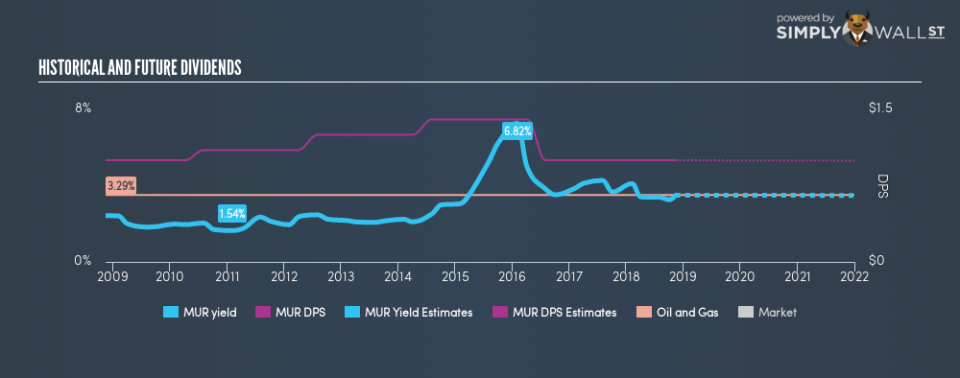Is Murphy Oil Corporation (NYSE:MUR) A Good Dividend Stock?

Dividends play a key role in compounding returns over time and can form a large part of our portfolio return. Historically, Murphy Oil Corporation (NYSE:MUR) has been paying a dividend to shareholders. Today it yields 3.3%. Does Murphy Oil tick all the boxes of a great dividend stock? Below, I’ll take you through my analysis.
See our latest analysis for Murphy Oil
5 checks you should use to assess a dividend stock
When assessing a stock as a potential addition to my dividend Portfolio, I look at these five areas:
Is its annual yield among the top 25% of dividend-paying companies?
Does it consistently pay out dividends without missing a payment of significantly cutting payout?
Has dividend per share risen in the past couple of years?
Can it afford to pay the current rate of dividends from its earnings?
Will the company be able to keep paying dividend based on the future earnings growth?
How well does Murphy Oil fit our criteria?
The company currently pays out more than double of its earnings as a dividend, according to its trailing trailing twelve-month data, meaning that the dividend is predominantly funded by retained earnings. In the near future, analysts are predicting a more sensible payout ratio of 27%, leading to a dividend yield of around 3.3%. In addition to this, EPS should increase to $4.19, meaning that the lower payout ratio does not necessarily implicate a lower dividend payment.
When thinking about whether a dividend is sustainable, another factor to consider is the cash flow. A business with strong cash flow can sustain a higher divided payout ratio than a company with weak cash flow.
If there’s one type of stock you want to be reliable, it’s dividend stocks and their stable income-generating ability. Not only have dividend payouts from Murphy Oil fallen over the past 10 years, it has also been highly volatile during this time, with drops of over 25% in some years. These characteristics do not bode well for income investors seeking reliable stream of dividends.
Compared to its peers, Murphy Oil generates a yield of 3.3%, which is on the low-side for Oil and Gas stocks.
Next Steps:
Now you know to keep in mind the reason why investors should be careful investing in Murphy Oil for the dividend. But if you are not exclusively a dividend investor, the stock could still be an interesting investment opportunity. Given that this is purely a dividend analysis, I urge potential investors to try and get a good understanding of the underlying business and its fundamentals before deciding on an investment. There are three essential aspects you should further research:
Future Outlook: What are well-informed industry analysts predicting for MUR’s future growth? Take a look at our free research report of analyst consensus for MUR’s outlook.
Valuation: What is MUR worth today? Even if the stock is a cash cow, it’s not worth an infinite price. The intrinsic value infographic in our free research report helps visualize whether MUR is currently mispriced by the market.
Dividend Rockstars: Are there better dividend payers with stronger fundamentals out there? Check out our free list of these great stocks here.
To help readers see past the short term volatility of the financial market, we aim to bring you a long-term focused research analysis purely driven by fundamental data. Note that our analysis does not factor in the latest price-sensitive company announcements.
The author is an independent contributor and at the time of publication had no position in the stocks mentioned. For errors that warrant correction please contact the editor at editorial-team@simplywallst.com.

